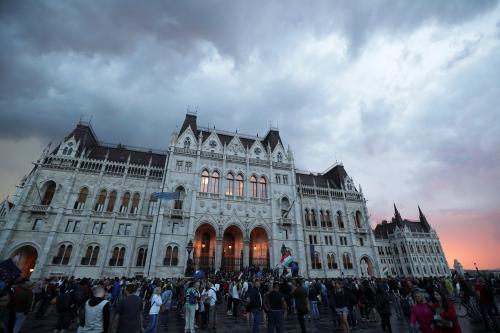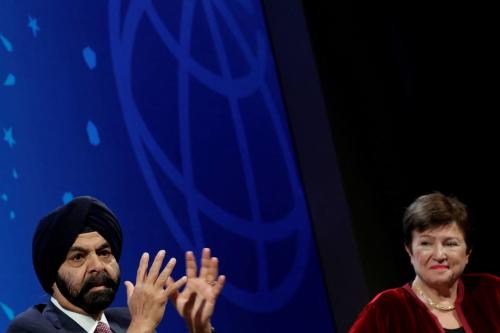“Liberal institutionalism,” the line of thinking that inspired how our world has been ordered since at least the 1940s, assumes that domestic and international institutions facilitate cooperation and peace among countries. So for many people what’s happening today is puzzling and even frightening. Liberal democracies like the United States and the United Kingdom—which for so long have been among the world’s great powers—seem desperate to leave the clutches of formidable international institutions that supposedly demand too much. At the same time, non-liberal countries like China are willing not only to stay but to take on more leadership responsibilities.
We don’t have a crystal ball to predict the future of liberal institutionalism, but we do know its past. In a contribution to a new book on International Organization and Global Governance, we try to distill the lessons. The bottom line: liberal institutionalism is in trouble, but it always has been.
Lesson 1: Kant said we can
Liberal institutionalists see high prospects for sustained cooperation. In his 1795 essay Perpetual Peace, political philosopher Immanuel Kant laid out a roadmap for getting there. Countries can surmount their innate attraction to power, competition, and armed conflict by forming like-minded groups—especially republican democracies—and binding themselves with domestic and international institutions. Kant’s roadmap later was repackaged in the Fourteen Points that U.S. President Woodrow Wilson articulated after the First World War.
The roadmap surfaced again in 1941 when U.S. President Franklin D. Roosevelt spotlighted the “four freedoms” that ought to spread throughout the United States and the world. Approximated in a host of post-World War II institutions—the United Nations (U.N.), the World Bank, the North Atlantic Treaty Organization (NATO), the General Agreement on Tariffs and Trade (GATT), and others—these values and institutions are the foundation of today’s “liberal world order.”
Lesson 2: Universalist principles, but not universally shared
Kant envisioned the system widening over time. The in-group would expand as more states signed onto the “universalist” values that guide how all members of this in-group must be treated. Unfortunately, there’s a flipside: until all countries reciprocate an identical set of universalist values, there will be not only an in-group but also an out-group. As the in-group grows, the out-group loses members and faces even higher costs for remaining outside. The optimistic view is that these hardships will make outsiders more inclined to join international institutions. But what also happens is that the out-group sees the in-group as the source of their pain. The stark truth is that many of today’s domestic governance standards and international institutions reflect the experiences and expectations of the former Western bloc: a handful of North American and Western European countries that were among the first liberal democracies.
To the many additional countries that have adopted these standards and institutions, the West still seems to have an edge because it wrote the rules. Over the years, this has prompted out-group outcry: not just from predictable naysayers like non-liberal governments, but also from developing countries, feminists, Marxists, and others. They resist, which means that so long as the system isn’t yet all-encompassing, cooperation and peace will be fragile, partial, and intermittent. Even when members of the out-group end up joining the in-group, their earlier resentments are not magically erased.
Lesson 3: In-group pain and blame
The in-group’s fluidity has a flipside of its own: if the in-group can expand, it can also contract. In fact, its expansion can fuel its contraction. When the in-group encompasses countries that are not as accustomed to international reciprocity, have somewhat different interpretations of the system’s core values, or resent how the system seems foisted on them, then both the earlier and later joiners can feel cheated. We are seeing this in the U.S. right now, with grumbling about free riders and bad deals in a system the U.S. itself constructed. We are also seeing it in the U.K., which is recoiling from Brussels’ attempts to synthesize policymaking among 28 different European Union member-states in Western and Central Europe.
But we’ve seen this before. We saw it in the first half of the 20th century when countries abandoned the League of Nations one by one and tumbled into economic crises and armed conflict—and then resurfaced with the determination to construct the U.N. We saw it in the 1970s too, when American leaders questioned the winnability of the Cold War and openly debated whether they should or could continue propping up collective defense or freer trade—and then emerged just two decades later in a world that seemed to have no remaining rivals to the United States. Pain and blame in the in-group is real, but it also ebbs and flows.
Lesson 4: The comeback kid
The three lessons above are linked. Kant’s perpetual peace is more of a goal than a prediction. Ironically, we should expect this path to peace to be marked by tensions and even all-out war, because as long as universalism is incomplete, resentments bubble between out-groups and in-groups. And even as the in-group inches closer to universalism, it brings some of these resentments inside and carries them forward. For all of these reasons, liberal institutionalism has repeatedly seemed on the verge of being reduced to ashes.
But it has kept rising from those ashes. The grievances now being trumpeted in the West and other parts of the world are not that different from those of the 1930s, 1970s, and other periods. The really important question isn’t whether international institutions will make a comeback but whether they can do it in a way that preserves the mantle of being “liberal.” Other questions follow: If governments lose patience, could the system be stabilized by civil society groups or firms? Does the survival of international institutions depend on the preservation of democratic domestic institutions? Could the liberal world order, established by democratic Western countries, be maintained by a powerful non-liberal country such as China?
Be careful about betting against liberal institutionalism: it’s not immortal, but it does possess uncanny powers of rebirth.







Commentary
Liberal institutionalism—its threatened past, its threatened future
July 18, 2018